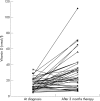Reactivation of tuberculosis and vitamin D deficiency: the contribution of diet and exposure to sunlight
- PMID: 17526677
- PMCID: PMC2117124
- DOI: 10.1136/thx.2006.070060
Reactivation of tuberculosis and vitamin D deficiency: the contribution of diet and exposure to sunlight
Abstract
Background: As well as its role in the regulation of calcium metabolism, vitamin D is an immunoregulatory hormone. Epidemiological evidence also suggests a link between vitamin D deficiency and tuberculosis (TB). A study was undertaken to examine serum vitamin D concentrations before treatment in patients with active TB and their contacts from the same ethnic and social background and to investigate the relative contributions of diet and sunlight exposure.
Methods: Serum vitamin D concentrations were measured before treatment in 178 patients with active TB and 130 healthy contacts. The prevalence of vitamin D deficiency and its relation to skin colour, month of estimation and TB diagnosis were determined. 35 patients and 35 frequency-matched contacts completed dietary and sun exposure questionnaires to determine the relative contribution of these to serum vitamin D concentrations.
Results: There was a statistically significant difference in serum vitamin D concentrations between patients and contacts (20.1 vs 30.8 nmol/l, 95% CI 7.1 to 14.3; p<0.001) and significantly more patients had severely deficient concentrations (<21 nmol/l) than controls (114/178 (64%) vs 40/130 (31%), p<0.001). There was no association between serum concentrations of vitamin D and skin pigmentation. The healthy contacts showed a predictable seasonal pattern, rising to peak concentrations in the summer months, but this response was absent in patients with TB. Dietary intake was the same in both patients with TB and contacts matched for age, sex and skin colour, but patients with TB displayed a stronger correlation between serum vitamin D concentrations and dietary intake (r = 0.42, p = 0.016) than controls (r = 0.13, p>0.1). There was no difference in sunlight exposure between the groups.
Conclusions: Patients with active TB have lower serum vitamin D concentrations than contacts from similar ethnic and social backgrounds and with comparable dietary intake and sun exposure, and do not show the expected seasonal variation. These observations indicate that other factors are contributing to vitamin D deficiency in patients with TB and suggest abnormal handling of this vitamin.
Conflict of interest statement
Conflict of interest: None.
References
-
- Chan T Y. Vitamin D deficiency and susceptibility to tuberculosis. Calcif Tissue Int 200066476–478. - PubMed
MeSH terms
Substances
LinkOut - more resources
Full Text Sources
Medical
Research Materials



